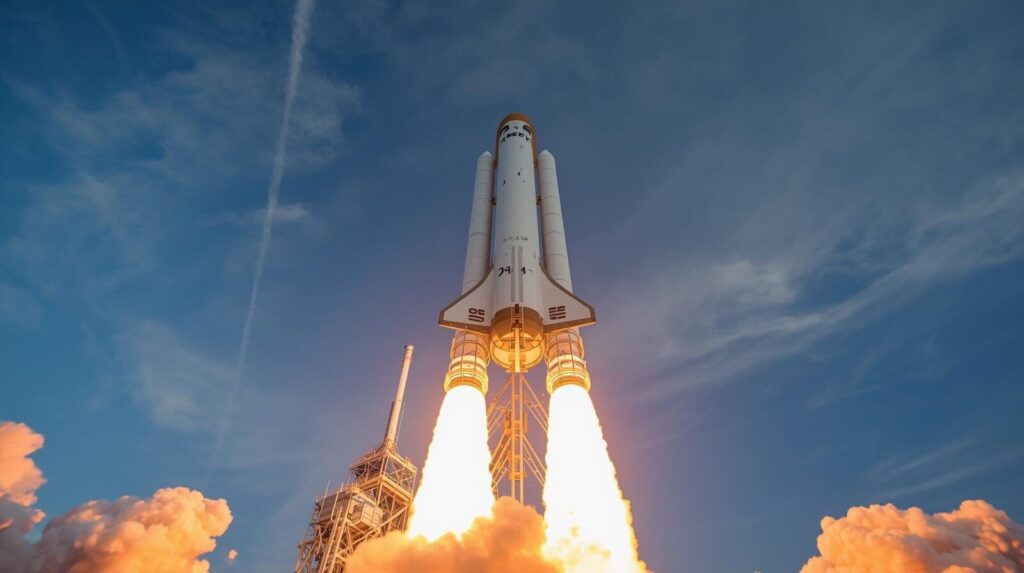American Leadership in Space Technology
American leadership in space technology has always been about pushing limits, from Apollo’s lunar triumph to today’s high-stakes race. In ’69, Armstrong’s boots stirred Moon dust, a moment that defined us as trailblazers. Now, in 2025, China’s lunar plans and Russia’s orbital threats test our grit. Staying first means blending NASA’s vision with private hustle to secure our future.
Space powers our lives, from GPS guiding your commute to satellites warning of storms. Losing our edge risks rivals controlling systems vital to our economy and defense. Orbital debris could spark Kessler syndrome, clogging space with junk. Leading here lets us shape rules and unlock lunar energy or satellite-driven farming.
NASA’s Artemis program drives our push to the Moon and beyond with bold ambition. Artemis II, set for 2026, will send four astronauts on a lunar flyby. The Space Launch System faces delays from Artemis I’s heat shield woes. A $25 billion budget fuels jobs, keeping NASA a cornerstone of exploration.
Private firms like SpaceX are slashing costs with reusable rockets like Starship. By August 2025, five of ten test flights succeeded, refining reusability. Blue Origin and Rocket Lab open space to startups and researchers. Their agility amplifies NASA’s reach, driving innovation at warp speed.
China’s Tiangong station and lunar sample missions show their relentless drive. Russia’s anti-satellite weapons threaten our orbital networks. These moves mirror earthly rivalries, with global influence on the line. We must counter with speed and ingenuity to stay ahead.
Budget cuts could stall NASA’s momentum, weakening our space efforts. Supply chain issues for rare earths and a STEM talent shortage add risks. Orbital debris threatens missions, potentially locking us out of space. Smart policies and investments are critical to overcome these hurdles.
American leadership in space technology thrives on public-private partnerships. The Space Force’s commercial strategy taps firms for cost-effective launches. Streamlined FAA rules can boost launch frequency, keeping us nimble. The Artemis Accords set global standards for peaceful lunar exploration.
Investing in STEM ensures our future in space exploration and innovation. K-12 programs and scholarships spark curiosity in young minds. Veteran retraining fills workforce gaps with skilled hands. Talent is our greatest asset to maintain dominance in space.
Space tech drives economic growth, from satellite data to lunar mining. Helium-3 could fuel clean fusion, slashing carbon emissions worldwide. Precision farming, guided by satellites, boosts global food security. These breakthroughs depend on America staying at the forefront.
Geopolitical tensions make space leadership urgent—missteps could spark conflicts. The Artemis Accords unite allies under our vision for cooperation. Diplomacy keeps space peaceful, with America steering the course. We lead through strength and shared goals.
SpaceX’s Starship, set for Artemis landings, shows private-sector power. Small satellites make space accessible to universities and startups. AI-driven satellite swarms secure our networks, per Lockheed Martin. These innovations keep us ahead of rivals.

NASA’s lunar gateway will be a hub for science and Mars mission prep. Partnerships with Canada and Europe strengthen its global reach. It’s a symbol of our commitment to exploration. American leadership in space technology shines through this vision.
China’s Long March-10 and asteroid missions push their cosmic ambitions. Russia’s orbital tests threaten our satellite security. We must innovate faster to counter their progress. Agility is our edge in this race.
Congressional budget fights risk starving NASA’s critical programs. Rare earth shortages hamper rocket and battery production. Talent drain to tech giants weakens aerospace. Resolving these is key to staying number one.
Streamlined regulations can supercharge our launch cadence and innovation. FAA delays slow progress—fixing this is a quick win. More launches mean more data and discoveries. This agility keeps us competitive globally.
The Artemis Accords align nations for peaceful space exploration. They ensure fair lunar mining and debris control under our lead. American leadership in space technology shapes these global rules. Our values guide the cosmic frontier.
STEM investment fuels our future in space, from kids to professionals. Coding camps and aerospace degrees build a diverse talent pool. Veteran programs bring grit to the workforce. Without talent, our lead could slip to rivals.
Space tech’s economic potential is massive, from mining to clean energy. Orbital solar farms could power cities, cutting fossil fuel use. Satellites drive billions in trade and agriculture. Staying first unlocks these global benefits.
Geopolitical risks demand diplomacy to keep space cooperative. Summits prevent conflicts, from signal jams to orbital sabotage. American leadership in space technology ensures peaceful exploration. We lead with unity and vision.
Rocket Lab’s smallsats make space accessible, boosting our innovation. Their agility lets us test ideas without billion-dollar budgets. AI strengthens our satellite defenses against threats. This ecosystem fuels our cosmic edge.
NASA’s nuclear propulsion could cut Mars trip times, a bold leap. Budget support keeps this tech alive for deep-space missions. It’s a cornerstone of our ambitions. Staying first depends on funding these bets.
China’s reusable rockets and lunar plans match our own strides. Their taikonauts gain experience we must rival. American leadership in space technology counters with creativity. We thrive by staying nimble and bold.
The Space Force’s commercial partnerships stretch our resources smartly. They handle launches, freeing NASA for big dreams. This teamwork is our strength. It keeps us ahead without outspending rivals.
Orbital debris threatens missions—cleanup tech is a must. Global agreements, led by us, enforce responsible launches. American leadership in space technology pioneers these solutions. A cluttered sky isn’t an option.

STEM programs, from rural schools to urban labs, build our future. Rocket contests spark kids’ dreams of space exploration. Scholarships keep talent in aerospace, not apps. Our lead depends on these dreamers.
Space-based solar and lunar mining could transform energy markets. Helium-3 may fuel clean fusion, slashing emissions. These breakthroughs start with our lead. American leadership in space technology drives this future.
Rivals like China and Russia watch our every move closely. Their state-driven programs are rigid but relentless. We counter with innovation and agility. Our diverse approach keeps us ahead.
Artemis II tests systems vital for Mars, a critical milestone. Delays erode momentum—we must stay focused. NASA’s budget needs protection from cuts. American leadership in space technology hinges on execution.
Blue Origin’s New Glenn adds power to our launch capabilities. Competition drives costs down, opening space to all. This ecosystem fuels our dominance. American leadership in space technology thrives on it.
China’s asteroid missions and Russia’s threats raise the stakes. Their progress pushes us to innovate faster. American leadership in space technology demands urgency. We lead by acting now.
Streamlined FAA rules can boost our launch frequency. More launches mean more data and breakthroughs. It’s a practical step for dominance. American leadership in space technology needs this speed.
The Artemis Accords unite nations under our vision for space. They ensure peaceful exploration and fair resource use. American leadership in space technology shapes these rules. Our values guide the frontier.
STEM diversity, from underrepresented groups to veterans, strengthens us. Hands-on programs ignite passion for aerospace careers. American leadership in space technology needs this talent. Without it, we risk falling behind.
Space tech’s trillions in potential—mining, energy, connectivity—starts with us. Satellites drive global trade and agriculture today. American leadership in space technology fuels these economic wins. It’s our ticket to prosperity.
Geopolitical summits prevent orbital conflicts, keeping space peaceful. America’s leadership ensures cooperative exploration. We set the tone for the cosmos. American leadership in space technology is our legacy.
The lunar gateway anchors our ambitions, a hub for science and exploration. Allies like Canada amplify its global impact. It’s a symbol of our resolve. American leadership in space technology shines through it.
Private innovation, from SpaceX to Rocket Lab, is our rocket fuel. Their agility lets us test bold ideas fast. American leadership in space technology thrives on this ecosystem. It’s how we stay light-years ahead.
NASA’s Mars dreams rely on tech we’re building today, from propulsion to habitats. Artemis is the stepping stone, testing human limits. American leadership in space technology drives these bold bets. The future depends on our resolve.
China and Russia’s advances are warnings—we must move faster. Their state-driven programs lack our creativity. American leadership in space technology counters with innovation. We thrive under pressure.
The Space Force’s partnerships multiply our strength, a smart strategy. They free NASA for deep-space missions. American leadership in space technology shines in this teamwork. It’s our edge in the race.
Debris cleanup tech, like laser tracking, is urgent for safe orbits. Global rules, led by us, ensure responsible launches. American leadership in space technology must solve this. The sky’s too precious to lose.
STEM’s our foundation—every rocket needs dreamers and builders. Programs for kids and veterans build our future workforce. American leadership in space technology rests on these minds. They’re our ticket to the stars.
Space’s promise—clean energy, new medicines, global connectivity—is ours to claim. Lunar bases and Mars outposts start with us. American leadership in space technology turns dreams into reality. Let’s keep the stars in our graps.
